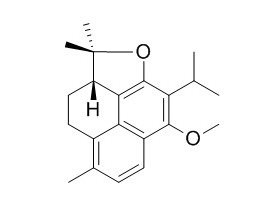Prionitin
Prionitin is a natural product from Salvia prionitis Hance.
Inquire / Order:
manager@chemfaces.com
Technical Inquiries:
service@chemfaces.com
Tel:
+86-27-84237783
Fax:
+86-27-84254680
Address:
1 Building, No. 83, CheCheng Rd., Wuhan Economic and Technological Development Zone, Wuhan, Hubei 430056, PRC
Providing storage is as stated on the product vial and the vial is kept tightly sealed, the product can be stored for up to
24 months(2-8C).
Wherever possible, you should prepare and use solutions on the same day. However, if you need to make up stock solutions in advance, we recommend that you store the solution as aliquots in tightly sealed vials at -20C. Generally, these will be useable for up to two weeks. Before use, and prior to opening the vial we recommend that you allow your product to equilibrate to room temperature for at least 1 hour.
Need more advice on solubility, usage and handling? Please email to: service@chemfaces.com
The packaging of the product may have turned upside down during transportation, resulting in the natural compounds adhering to the neck or cap of the vial. take the vial out of its packaging and gently shake to let the compounds fall to the bottom of the vial. for liquid products, centrifuge at 200-500 RPM to gather the liquid at the bottom of the vial. try to avoid loss or contamination during handling.
Foods.2023, 12(6):1227.
Food Chem.2024, 446:138870.
Plants (Basel).2023, 12(1):163.
Phytomedicine.2018, 38:45-56
Front. Physiol.2022, 790345.
Plants (Basel).2024, 13(23):3314.
FEBS Lett.2021, 595(20):2608-2615.
Food Chem.2020, 332:127412
Fitoterapia.2024, 175:105958.
Green Chem.2023, 25:5222-5232
Related and Featured Products
Journal of Organic Chemistry, 1992 , 57 (17).
Cyclization reactions of the o-naphthoquinone diterpene aethiopinone. A revision of the structure of prionitin.[Reference:
WebLink]
METHODS AND RESULTS:
The 4,5-seco-20(10→5)-abeo-abietane derivative aethiopinone (1), a natural o-naphthoquinone isolated from some Salvia species, was subjected to a series of acid-catalyzed reactions which yielded phenalene derivatives (2, 6, 9, and 11) and other cyclization products (3 and 10).
The 11-nor derivative 3 is formed by an intramolecular [4 + 2] cycloaddition reaction, and a mechanistic pathway for the formation of the phenalene derivatives 6 and 11 is also proposed. These transformations of aethiopinone (1) allowed the partial syntheses of the naturally occurring diterpenes salvipisone (8), salvilenone (9), and the racemic form of Prionitin (11), a rearranged abietane diterpenoid previously isolated from the root of Salvia prionitis, to which structure 12 had been attributed only on the basis of NMR spectroscopic studies.
CONCLUSIONS:
In the light of the results reported herein, including an X-ray analysis of compound 11, the structure 12 assigned to Prionitin must be changed to 11.



